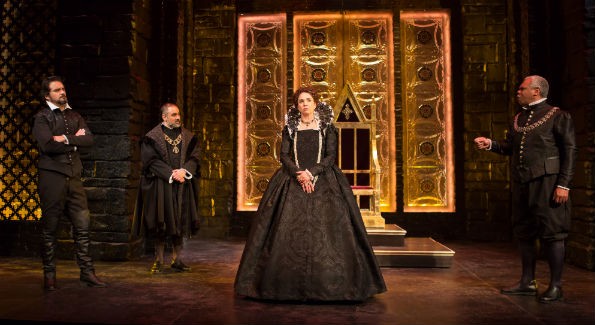‘Mary Stuart’ hauntingly portrays the bloody battle between Queen Elizabeth and Mary Queen of Scots.
In the 16th century, what would become a legendary political power struggle started between two ambitious, powerful women: Queen Elizabeth and Mary Queen of Scots. Both were masters of intrigue and manipulation and both were players in an England they understood wasn’t big enough for the two of them.
Their confrontation is retold in the Folger Theatre’s mesmerizing production of Friedrich Schiller’s “Mary Stuart.” First performed in 1800, Schiller’s play, in a new version by Peter Oswald, focuses on the clash between the two formidable women. A further complication was that Protestant Elizabeth was determined to hold onto her throne against Catholic Mary, who had a strong claim to it. The religious differences only exacerbated the conflict.
Richard Clifford, director of “Mary Stuart,” was aware that to portray these driven, ambitious queens he would need to cast two accomplished actors capable of understanding and able to project the fearsome power of the two women. He found them in Kate Eastwood Norris as Mary and Holly Twyford as Elizabeth. Both command their roles and seem to have been born to inhabit the complex personalities of the two queens.
“Mary Stuart” traces the final days of the Queen of Scots. She is imprisoned in England on charges of complicity in the murder of her husband, a subterfuge designed to provoke an official decree that would mandate her execution for her designs on the throne. A significant additional factor was the ongoing conflict between Catholics and the new Protestant religion established by Elizabeth’s father, King Henry VIII.
The confrontation between the queens in the Folger production is historically accurate. However, the intense face-to-face meeting between the two cousins did not occur. An electrifying scene on the Folger stage, it emphasizes the intense antipathy between the two rulers heading for an unavoidable collision.
In addition to the political and religious hostility, were their physical differences. Mary was a legendary beauty nearly six feet tall, sensuous and thrice married; Elizabeth, the Virgin Queen, was short and homely.
Elizabeth was under intense pressure from her advisors, especially from her counselor, Lord Burleigh, a dark, caped presence relentless in his hatred of Mary.
Rajesh Bose’s (Lord Burleigh) is perfectly menacing and opportunistic. He will not be deterred by his queen’s reluctance to sign the death warrant.
Elizabeth was also well aware she was the bastard daughter of Henry VIII, and she wanted the problem of Mary to go away without her entering into a dangerous regicide precedence: executing a queen. If Mary were to unexpectedly die in captivity, however, she could keep her distance and wouldn’t have to sign the execution decree.
The idea of Mary being found dead in her prison quarters is suggested to her conscientious jailer Sir Amias Paulet. He is told it would be a great service to his queen, but Paulet is a man of integrity and will not agree to the conspiracy. Louis Butelli sensitively portrays Paulet as a man who is reluctantly courageous in provoking Elizabeth’s wrath by not helping his queen avoid having a direct hand in Mary’s beheading.
Tony Cisek’s scenic design emphasizes the conflicting contrasts between the two women, especially Mary’s imprisoned disadvantage. When Mary has the stage, the lighting is subdued and the walls are an ominous black stone reaching to the rafters. But when the same stage opens for Elizabeth’s throne room, it is golden and white, so brilliantly lit that the sudden contrast is briefly painful to the eyes in Rob Denton’s harshly contrasting lighting design.
Black is the dominate color of all the costumes created by Mariah Hale. Mary is in an unadorned shapeless dress, while Elizabeth, as befitting a reigning monarch, is in a formal black gown, and she is festooned with jewels and ropes of pearls.
This updated version of “Mary Stuart” is more accessible and even though it runs for nearly three hours with several long speeches, the cast Clifford has assembled is effective and his efficient pacing makes that running time irrelevant.
The battle between Elizabeth and Mary does come to a bloody end. The conflict between the two canny, strong women was an important prologue across the subsequent centuries of the monocracies that have dominated the United Kingdom.
Mary Stuart continues through March 8 at Folger Theatre, 201 East Capitol St., SE. Tickets are $45-$65 and available at 202 544 7077 and online here.





